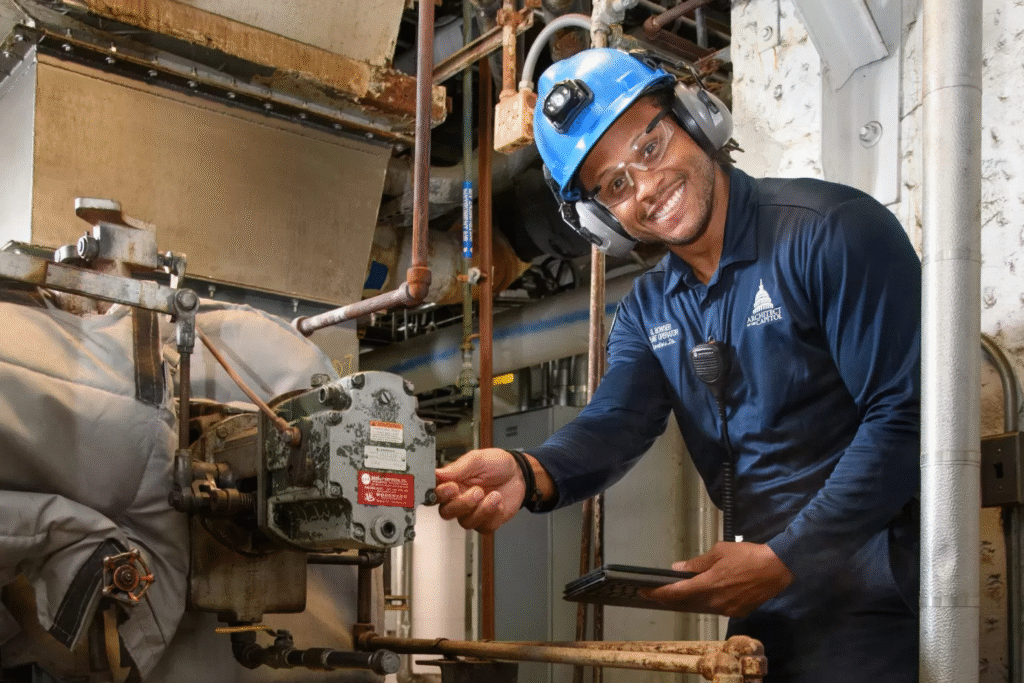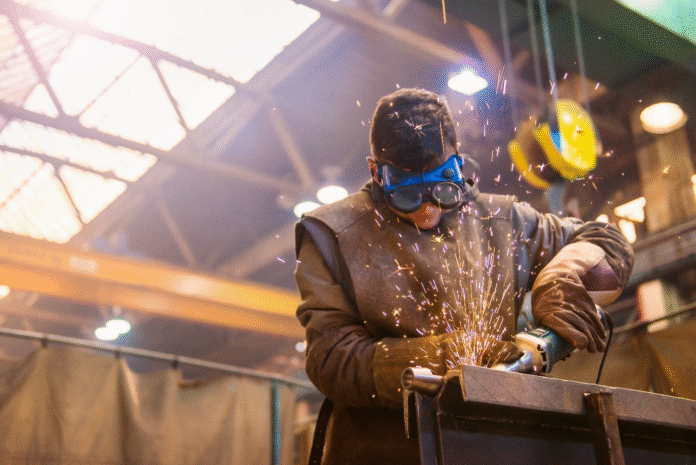When most people hear the phrase “blue collar jobs,” they picture someone in a hard hat or steel-toed boots, working long hours for modest pay. But here’s the truth: in 2025, many blue collar jobs are not only highly respected, they’re also highly paid — often rivaling, and sometimes exceeding, traditional white collar careers.
Blue collar simply refers to jobs that are more hands-on and trade-focused, usually outside of the typical office setting. Think electricians, aircraft mechanics, plumbers, welders, or even renewable energy technicians. These are the people who build our homes, keep our lights on, make sure planes stay in the air, and increasingly, help drive the transition to clean energy.
And the best part? You don’t need a four-year college degree to get started. In fact, many of the highest paying blue collar jobs in 2025 only require vocational training, apprenticeships, or certifications. With worker shortages hitting industries like construction, logistics, and green energy, salaries are climbing — giving skilled tradespeople more bargaining power than ever before.
In this guide, we’ll walk through some of the high paying blue collar jobs right now, what they actually earn, the skills you’ll need, and why they’re in demand. If you’ve ever wondered whether a blue collar career can lead to financial stability (or even six figures), the answer is a big, confident yes.
Table of Contents
What Counts as a Blue Collar Job?
The term “blue collar” has been around for more than a century. It originally described workers who wore durable, often blue uniforms on factory floors, construction sites, or in warehouses. Today, the meaning is broader but still refers to jobs built around hands-on skills and physical work rather than desk-bound office tasks.
Blue collar work covers a wide spectrum. It includes skilled trades like electricians, plumbers, and welders. It also covers fields such as manufacturing, transportation, and logistics, where workers keep supply chains running. Even newer areas like renewable energy installation fall under this category, because they rely on technical expertise and practical know-how.
The biggest difference between blue collar and white collar jobs is not intelligence or capability but the type of work performed. White collar jobs usually center on management, analysis, and office-based roles, while blue collar jobs focus on building, repairing, moving, and operating. Both are vital, but blue collar careers often provide a more direct and visible impact on daily life.
In 2025, many people are rethinking old stereotypes. Far from being low-skill or low-wage, modern blue collar jobs can be highly technical, well compensated, and essential to the economy. These careers are increasingly recognized as pathways to financial security, especially as demand for skilled labor continues to rise.
The Highest Paying Blue Collar Jobs in 2025
Blue collar careers are proving that hands-on work can deliver high salaries and long-term stability. In 2025, a wide range of skilled trades are not only in demand but also paying wages that rival or surpass many office-based roles. Below are some of the best-paying options, along with what they involve and how much workers can expect to earn.
1. Elevator Installers and Repair Technicians

Elevator and escalator specialists are among the most well-paid blue collar workers today. Their role is highly technical and safety-driven, which explains the strong pay.
- What they do: Assemble, install, and maintain elevators, escalators, and moving walkways.
- Skills needed: Mechanical know-how, electrical knowledge, strong safety awareness.
- Salary range: About $90,000 to $120,000 a year, with unionized workers often earning even more.
2. Power Plant Operators

Power plant operators manage complex systems that keep electricity flowing to homes and businesses. Although the field is smaller due to automation, the specialists who remain are very well compensated.
- What they do: Monitor power generation systems, adjust controls, and ensure energy output is stable.
- Skills needed: Technical training, strong attention to detail, certifications in energy operations.
- Salary range: Typically $80,000 to $110,000 annually.
3. Aircraft and Avionics Technicians

Keeping planes flight-ready is no small task. These workers ensure aircraft meet strict safety standards.
- What they do: Inspect, repair, and maintain aircraft engines, electronics, and navigation systems.
- Skills needed: FAA certifications, mechanical expertise, problem-solving under pressure.
- Salary range: $75,000 to $105,000, with higher pay in large airline hubs.
4. Plumbers, Pipefitters, and Steamfitters

Essential to both households and large industries, these professionals keep vital systems running.
- What they do: Install and maintain water lines, heating systems, and gas pipelines.
- Skills needed: Licenses, apprenticeships, physical stamina, and technical training.
- Salary range: $65,000 to $95,000 annually, with top-tier specialists earning more.
5. Electricians

Electricians remain one of the most consistently in-demand trades worldwide. Their work underpins nearly every building project.
- What they do: Wire homes, offices, and factories, repair electrical systems, and ensure compliance with codes.
- Skills needed: State licensing, apprenticeship completion, strong troubleshooting ability.
- Salary range: $65,000 to $90,000 annually, with master electricians approaching six figures.
6. HVAC Technicians

Climate control is no longer a luxury — it’s a necessity. HVAC professionals make sure heating and cooling systems run efficiently.
- What they do: Install, repair, and maintain heating, ventilation, and air-conditioning systems.
- Skills needed: Technical certifications, knowledge of new energy-efficient systems, hands-on training.
- Salary range: $60,000 to $85,000 a year.
7. Construction Supervisors and Managers with Trade Backgrounds
Workers who rise through the trades into supervisory roles often command high salaries. Their experience gives them credibility with crews and confidence from employers.
- What they do: Oversee construction projects, manage crews, handle budgets and timelines.
- Skills needed: Trade experience, leadership skills, knowledge of safety and building codes.
- Salary range: $75,000 to $110,000, with large projects offering more.
8. Welders and Boilermakers

Precision welding and boiler maintenance are critical in industries like shipbuilding, energy, and heavy manufacturing.
- What they do: Weld metal structures, repair boilers, and ensure safety in high-pressure environments.
- Skills needed: Welding certifications, stamina, safety training.
- Salary range: $60,000 to $95,000, depending on specialization and industry.
9. Truck Drivers in Specialized Freight

Not all trucking jobs are high-paying, but specialized roles deliver excellent income potential.
- What they do: Transport oversized loads, hazardous materials, or long-haul freight.
- Skills needed: Commercial driver’s license (CDL), endorsements for hazardous or oversized loads, stamina for long drives.
- Salary range: $70,000 to $95,000, with six-figure earnings possible through bonuses.
10. Wind Turbine and Solar Technicians

Green energy has created new opportunities for blue collar workers, and pay is rising quickly as demand grows.
- What they do: Install and maintain wind turbines and solar energy systems.
- Skills needed: Technical training, safety awareness, adaptability to new technologies.
- Salary range: $60,000 to $85,000 annually, with strong job growth expected through the decade.
Why Blue Collar Salaries Are Rising
For years, many people assumed blue collar jobs would always pay less than office-based roles. In 2025, the opposite is happening in many industries. Wages in skilled trades are climbing, and in some cases outpacing white collar salaries. There are several reasons behind this shift.
Worker shortages
A large share of the current blue collar workforce is made up of older workers nearing retirement. Fewer young people have been entering the trades over the past two decades, often steered instead toward four-year college degrees. This mismatch has created a shortage of electricians, welders, plumbers, and other skilled laborers, driving wages higher as employers compete for talent.
Infrastructure and green energy spending
Massive investment in roads, bridges, clean energy, and manufacturing facilities is fueling demand for hands-on workers. Solar panel installers, wind turbine technicians, and heavy equipment operators are all seeing pay increases as governments and private companies roll out multi-billion dollar projects.
Resilience against outsourcing and automation
Many white collar jobs can be outsourced overseas or automated with software, but most blue collar work requires physical presence and practical skill. You cannot outsource the installation of a heating system or automate a wind turbine repair. This resilience makes tradespeople more valuable in an uncertain economy.
Union strength and bargaining power
In industries where unions remain strong, collective bargaining has secured better pay and benefits for workers. Even in non-union fields, shortages have tilted power toward employees, giving them more leverage to negotiate higher wages.
Expert opinion: Blue collar jobs which were once seen as a “backup option” is now, for many, the smartest path to financial security — and in some trades, a direct route to six-figure earnings.
Skills and Training You’ll Need
Blue collar jobs may not ask for a fancy diploma hanging on your wall, but they do expect real skills that can’t be faked. If you want to land one of the high paying roles we just covered, here are the areas you’ll need to focus on.
Technical training and certifications
Think of certifications as the driver’s license for your career. Nobody’s going to let you wire up a house or repair an aircraft engine if you don’t have proof you know what you’re doing. Trade schools, community colleges, and apprenticeship programs are the main gateways. For example, the U.S. Department of Labor Apprenticeship program connects workers to hands-on training that leads directly to jobs.
Apprenticeships and hands-on learning
Unlike office jobs where you might survive by nodding in meetings, blue collar work demands proof in action. Apprenticeships let you earn while you learn, working under an experienced mentor. This is how most electricians, plumbers, and welders build their careers. You don’t just sit in a classroom — you actually do the work from day one.
Physical stamina and safety awareness
A desk job might only risk paper cuts, but trades involve heavy tools, loud machines, and sometimes dangerous heights. Physical fitness matters, and so does safety training. Employers want workers who respect safety rules, not daredevils who cut corners. OSHA (the Occupational Safety and Health Administration) provides clear guidelines that most trade workers must follow.
Problem solving and adaptability
Every worksite is different, and things rarely go exactly as planned. Pipes burst, machines jam, and equipment sometimes refuses to cooperate. Employers love workers who can stay calm, figure things out, and keep moving. Being able to “MacGyver” a temporary fix — safely, of course — is often what separates average workers from the ones who get promoted.
Digital and tech literacy
Even blue collar work is changing with technology. Electricians now use smart home systems, truck drivers navigate with advanced GPS logistics, and HVAC techs rely on computer diagnostics. You don’t have to be a software engineer, but knowing how to use digital tools is quickly becoming part of the job. The Bureau of Labor Statistics has noted that technology is now central to many trade careers.
Pros and Cons of High Paying Blue Collar Jobs
Like every career path, blue collar work comes with its own set of ups and downs. Some people love the hands-on nature, while others might find the hours or physical demands tough. If you’re thinking about joining this world, it helps to see both sides.
Pros
Solid pay without student debt
Many blue collar workers earn incomes that rival — and sometimes beat — college graduates. The difference is they didn’t need to spend four years (and sometimes six figures) at a university. Apprenticeships often let you earn while you learn, so you get a paycheck instead of a tuition bill.
Job security in essential industries
Try to imagine life without plumbers, electricians, or truck drivers. You can’t. These are roles society depends on daily. Even during economic downturns, blue collar workers often remain in high demand because people still need power, water, transportation, and repairs.
Visible results and pride in work
There’s something rewarding about pointing to a finished building, a repaired engine, or a working power line and saying, “I did that.” Unlike many office jobs, the results of blue collar work are clear and immediate. That kind of pride is worth more than a line in a spreadsheet.
Pathways to advancement
Many supervisors, managers, and even business owners started as trade workers. With experience, you can climb the ladder, start your own company, or specialize in areas that pay even more.
Cons
Physically demanding
Blue collar work often involves heavy lifting, long hours on your feet, or outdoor conditions. You won’t be sitting in a climate-controlled office with ergonomic chairs. If you don’t like sweating, lifting, or sometimes getting a little dirty, this path might not feel like a fit.
Higher safety risks
There’s no sugarcoating it — working with heavy machinery, electricity, or chemicals can be dangerous. That’s why training and safety rules are so important. While the risks are managed, they are part of the job in ways most office workers never face.
Irregular schedules
Some trades require night shifts, early mornings, or being on call for emergencies. If a pipe bursts at 2 a.m., the plumber is the hero, but it also means interrupted sleep. Not every trade has this issue, but flexibility is often required.
Limited remote work
While many white collar jobs moved online, you can’t fix an elevator or install solar panels over Zoom. These jobs demand physical presence. For some people, that’s a positive — for others, it’s a deal breaker.
Future Outlook — Will These Jobs Stay High Paying?
One big question people ask before jumping into a blue collar career is whether the pay will hold up in the future. Nobody wants to train for a trade only to see the demand vanish in a few years. The good news is that many blue collar jobs are not only here to stay but are expected to grow stronger through the decade.
Growing demand in green energy
Jobs in renewable energy, like wind turbine and solar technicians, are among the fastest-growing occupations in the United States. Governments and private companies are pouring billions into clean energy projects, and someone has to install and maintain all that equipment. These jobs are not only safe from outsourcing, they are tied directly to long-term global energy shifts.
Aging workforce creates shortages
A large number of skilled workers are nearing retirement. The U.S. Bureau of Labor Statistics projects that construction and trade industries will need hundreds of thousands of new workers just to replace retirees. This gap means higher demand and stronger wages for younger workers who enter the field now.
Infrastructure and manufacturing investment
Major investment bills in the U.S. and similar spending abroad are putting money into roads, bridges, rail, and factories. Every one of those projects requires electricians, welders, heavy equipment operators, and supervisors. These projects take years to complete, which translates into steady demand and good pay.
Automation is less of a threat
Yes, machines are getting smarter. But a robot can’t crawl under your sink, climb a power pole, or weld a pipe in a tight corner. Many white collar roles face automation pressure, while trades remain grounded in hands-on skill. Instead of replacing workers, new tech is helping them work safer and faster.
Rising respect and awareness
Society is also slowly shaking off the old idea that blue collar means “less than.” Skilled trades are being recognized as professional, lucrative, and essential. This cultural shift may not raise wages directly, but it attracts more investment into training and career development, which strengthens the field over time.
The bottom line: Blue collar jobs are not going away. In fact, they are becoming some of the most reliable ways to earn a strong income in a world that desperately needs skilled labor. For anyone looking to build a stable, high-paying career without drowning in student debt, the future looks bright.
Conclusion
For too long, blue collar jobs carried an unfair label of being low pay or “second choice” careers. The reality in 2025 is very different. Many of these roles not only pay as much as white collar work, but they also come with real security, pride, and long-term potential. From elevator installers making six figures to renewable energy technicians riding the green boom, blue collar workers are shaping the backbone of modern life.
If you enjoy working with your hands, solving problems in the real world, and seeing visible results from your effort, this path can be both rewarding and profitable. The best part is you don’t need to drown in student loans or spend years in a lecture hall before you start earning. With the right training and persistence, you can build a solid career that keeps the bills paid and your future secure.
Of course, the work is not always easy. There will be long days, heavy lifting, and the occasional job that leaves you sore. But there’s also pride in knowing that when the lights turn on, the water runs, or the plane takes off, your skill made it possible.
The bottom line: Blue collar jobs are not just surviving — they are thriving. If you’re looking for a career with good pay, real stability, and a sense of purpose, the trades might just be the smartest move you can make this year.
Want more career insights and money advice written in plain English? Visit Investment-Guru.net for guides that help you earn more, save smarter, and build lasting wealth.
FAQs on High Paying Blue Collar Careers
What is the highest paying blue collar job in 2025?
Elevator installers and repair technicians continue to top the charts. Their work is highly specialized, requires deep training, and comes with big safety responsibilities. It’s not unusual to see experienced workers earning well over $100,000 a year.
Can you really make six figures without a college degree?
Yes, and plenty of people do. Many blue collar careers pay into the six-figure range after a few years of experience or with the right certifications. It may take sweat, training, and showing up early, but you won’t need a framed diploma to make it happen.
Are blue collar jobs disappearing?
Not at all. While some factory roles have been automated, most skilled trades are growing. You can’t outsource plumbing, electrical work, or renewable energy installation to another country. These jobs require people on the ground, and the Bureau of Labor Statistics projects steady growth for many of them.
Which blue collar jobs are safest from automation?
Jobs that involve problem-solving in unpredictable environments — like electricians, plumbers, HVAC technicians, and renewable energy workers — are very safe. Machines do great with repetitive tasks, but they don’t handle “figure it out on the spot” work very well. That’s where human skills win.
Can someone switch from a white collar job to a blue collar career?
Absolutely. Many people leave office jobs to learn a trade and end up earning more while feeling happier with their work. If you’re willing to train and start at the beginner level, you can build a whole new career path. Plus, you’ll have a skill that will always be useful, even outside of work.
Do blue collar jobs offer good benefits?
It depends on the employer and whether the role is unionized. In union-heavy trades, workers often enjoy strong healthcare and retirement benefits. Even in non-union roles, many employers offer competitive packages to attract scarce talent.
How long does it take to train for a blue collar career?
Training can take anywhere from a few months in a certificate program to four years in an apprenticeship. The difference is that apprenticeships pay you while you learn, so you’re not sitting in class with bills piling up. Most workers can start earning relatively quickly compared to traditional college routes.


